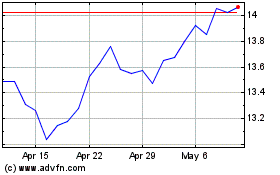As Coronavirus Spreads, Banks Face Tough Call on Branch Closures -- 2nd Update
March 19 2020 - 7:30PM
Dow Jones News
By Orla McCaffrey
The coronavirus pandemic is forcing U.S. banks to begin closing
branches indefinitely, an unprecedented measure that could curb the
virus's spread but rattle customers who expect instant access to
their money.
JPMorgan Chase & Co. said it would close 20% of its nearly
5,000 branches starting Thursday. The bank already had scaled back
weekday hours at its branches. Capital One Financial Corp. on
Monday closed about a quarter of its 461 branches -- about half in
New York City -- to "minimize health risks from the
coronavirus."
Truist Financial Corp. and PNC Financial Services Group Inc.
will restrict branch access to drive-through lanes and
appointments, except at some key branches that lack drive-throughs.
Regions Financial Corp., Huntington Bancshares Inc. and Fifth Third
Bancorp also plan to limit contact at branches to drive-throughs
and appointments.
"We were having several dozen people in our branch lobbies, and
we couldn't control it," said Huntington Chief Executive Stephen
Steinour. "We had customers say they didn't feel safe with that
kind of crowd."
As the coronavirus pandemic spreads throughout the U.S., banks
occupy a unique position. They are among the few businesses deemed
essential and not subject to government-ordered shutdowns.
Yet banks that choose to close must strike a delicate balance --
taking measures to keep employees safe while assuring customers
they can access their money through a full slate of digital
services or at a nearby branch. The greatest risk for banks is how
the closures are perceived, industry analysts said.
"You can't separate people from their money and maintain the
confidence of the person in the banking system," said banking
analyst Dick Bove.
The top three federal banking regulators reminded banks last
week that short-term shutdowns are permissible when the
circumstances are out of their control. The Office of the
Comptroller of the Currency advised banks to "provide alternative
service options when possible, and reopen affected facilities when
it is safe to do so."
Lightly staffed locations near other branches are easier to
close. Those with drive-through lanes that put distance between
customers and employees are more likely to stay open. Capital One
said it prioritized closing locations that lack the lanes or
protective glass to separate tellers from customers.
Community banks and those near early clusters of coronavirus
were among the first to close branches.
Wintrust Financial Corp. said this week it would close or alter
services at 50 of its branches in Illinois and Wisconsin. Heritage
Bank, a 67-branch bank in Washington state, told customers that,
beginning Wednesday, it would close all branch lobbies through the
end of March.
Many banks are providing customer-facing employees with
additional paid time off and advising high-risk staffers to stay
home. Some are reimbursing child-care costs for workers dealing
with school closings.
The decision to keep branches open is putting some workers on
edge. At a Wells Fargo & Co. location in the Seattle area, more
tellers than usual are calling out sick, according to a branch
employee. Some higher-level staffers have been asked to fill in,
handling transactions at the teller window and counting money in
the back office.
The employee said his manager denied a request to work from
home, even though his clients have canceled meetings and stopped
walking into the branch. He said he is concerned about transmission
because almost all staffers at his branch are in the office each
day.
Wells Fargo stopped using many of its drive-throughs earlier
this year as part of a push to encourage customers to use its apps
and otherdigital services. A spokeswoman said the bank is using
drive-throughs in some locations to limit interaction.
Wells Fargo said it is working to reduce the staff count at its
branches, directing most employees who don't interact with
customers to work from home and staggering shifts for
customer-facing workers.
"We are following national- and local-government-issued
guidelines, and we are providing regular updates to our employees
as the situation evolves," the spokeswoman said.
Write to Orla McCaffrey at orla.mccaffrey@wsj.com
(END) Dow Jones Newswires
March 19, 2020 19:15 ET (23:15 GMT)
Copyright (c) 2020 Dow Jones & Company, Inc.
Huntington Bancshares (NASDAQ:HBAN)
Historical Stock Chart
From Mar 2024 to Apr 2024

Huntington Bancshares (NASDAQ:HBAN)
Historical Stock Chart
From Apr 2023 to Apr 2024
